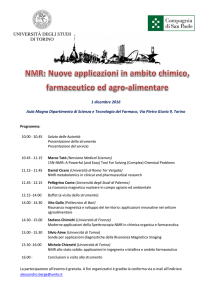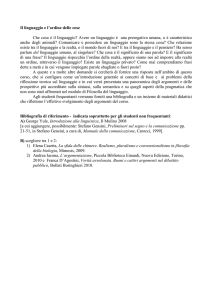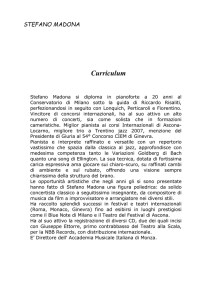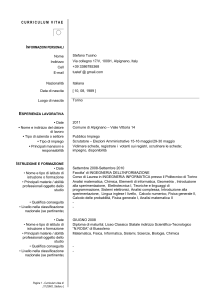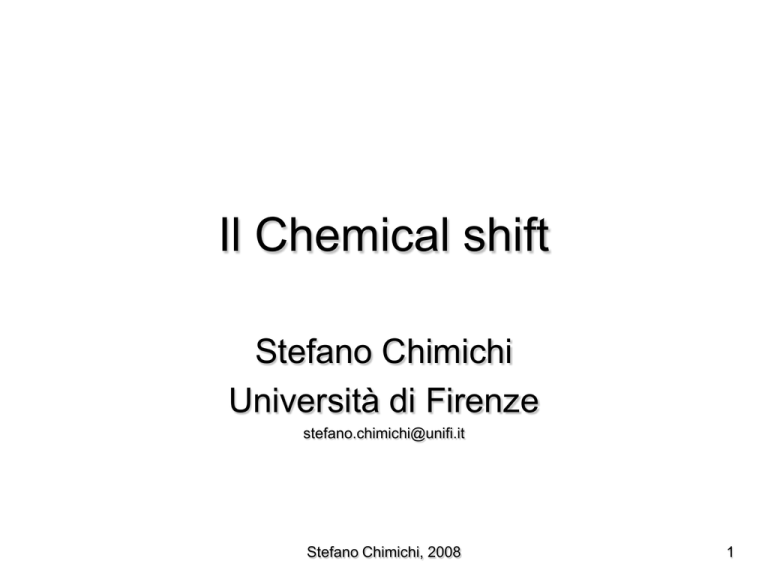
Il Chemical shift
Stefano Chimichi
Università di Firenze
[email protected]
Stefano Chimichi, 2008
1
I Parametri NMR*
Il Chemical Shift
Le Costanti di Accoppiamento
L’integrazione dei segnali
*Altri fenomeni quali rilassamento, effetto nucleare Overhauser ecc. saranno trattati
in lezioni successive
Stefano Chimichi, 2008
Il Chemical Shift
Stefano Chimichi, 2008
Se il campo magnetico fosse omogeneo, ci dovremmo
aspettare che ogni isotopo nucleare desse luogo ad un
singolo
picco
alla
propria
frequenza
precessionale
(frequenza di Larmor):
Joseph Larmor (1857-1942)
Stefano Chimichi, 2008
Frequenza precessionale =
Frequenza di Larmor
ν0 = - γ B0 /2π
frequenza di Larmor in Hz
(= cicli per secondo)
campo magnetico in
Tesla (T)
rapporto giromagnetico in
rad s–1 T–1 (detto anche
“valore-g”)
Quindi, per quanto detto finora, l'NMR sarebbe un metodo analitico
alquanto inutile. Ogni nucleo attivo entrerebbe in risonanza con il campo
esterno alla sua frequenza e tutti gli isotopi uguali si comporterebbero
allo stesso modo (un unico segnale).
Stefano Chimichi, 2008
isotope
natural
abundance
spin
gyromagnetic
ratio
γ/rad s–1 T-1
Larmor
frequency
(MHz) in a
field B0 =
11.7433 T
1
H
99.98%
1/2
267.5 × 106
-500.00
2
H
0.015%
1
41.1 × 106
-76.75
10
19.9%
3
28.7 × 106
-53.72
12
98.9%
0
-
-
13
C
1.1%
1/2
67.2 × 106
-125.72
14
N
99.6%
1
19.3 × 106
-36.13
15
0.37%
1/2
-27.1 × 106
+50.68
16
99.96%
0
-
-
17
0.04%
5/2
-36.3 × 106
+67.78
F
100%
1/2
251.8 × 106
-470.47
Na
100%
3/2
70.8 × 106
-132.26
100%
5/2
69.8 × 106
-130.29
100%
1/2
108.4 × 106
-202.61
B
C
N
O
O
19
23
27
Al
31
P
Stefano Chimichi, 2008
What’s a Tesla?
1 T = 10,000 gauss = 42.6 MHz
Stefano Chimichi, 2008
A 9.4 T avremmo ad es.
Tutti gli atomi di 1H
Tutti gli atomi di
Tutti gli atomi di
13C
29Si
Eccetera...
Stefano Chimichi, 2008
In realtà, per nostra fortuna, l’effettiva (reale) frequenza di Larmor di
un nucleo dipende dal suo intorno atomico.
Vi sono DUE importanti effetti microscopici che
drammaticamente la frequenza di Larmor di un dato spin:
influenzano
Poiché gli elettroni sono magnetici, la frequenza di Larmor dello spin
in esame dipenderà dall’intorno elettronico. Questo effetto viene
chiamato chemical shift nei materiali diamagnetici, Knight shift nei
metalli e nei superconduttori e paramagnetic shift nelle sostanze
paramagnetiche.
La frequenza di Larmor dipende dalla presenza di altri spin nucleari
magnetici nella stessa molecola e dalle direzioni dei loro momenti
magnetici: questo effetto è detto accoppiamento nucleare spin-spin.
Stefano Chimichi, 2008
I due effetti sono estremamente utili perché fanno sì che
un nucleo possa fornire informazioni sul proprio intorno
chimico.
Infatti i segnali NMR forniscono informazioni sugli intorni
elettronico e nucleare degli spin osservati.
Stefano Chimichi, 2008
INFATTI….
come dicevamo, nelle molecole reali il segnale NMR di un certo nucleo
risulta spostato nello spettro a seconda del suo intorno chimico.
Il campo magnetico al nucleo non è uguale al campo magnetico applicato
(esterno); gli elettroni attorno al nucleo fungono da schermo (shield) rispetto al
campo applicato. La differenza tra il campo magnetico applicato ed il campo
effettivo risentito dal nucleo viene detta shielding nucleare.
Se consideriamo gli elettroni s in una molecola vediamo che essi hanno simmetria
sferica e che si muovono circolarmente nel campo magnetico applicato,
producendo così un campo magnetico che si oppone (legge di Lenz) al campo
applicato stesso (materiali diamagnetici).
Stefano Chimichi, 2008
Chemical shift
Levitt
Electrons surrounding a nucleus create a magnetic field
(“shield”) which affects the size of the magnetic field seen
at the nucleus
Stefano Chimichi, 2008
Il chemical shift è principalmente un’interazione di natura intramolecolare
anche
se
vi
possono
essere
componenti
significative
di
natura
intermolecolare.
Come accennato, il meccanismo del chemical shift è un processo a due stadi:
(a) il campo magnetico esterno B0 induce correnti nella nuvola elettronica
della molecola, (b) le correnti molecolari circolanti a loro volta generano un
campo magnetico detto Bindotto.
Gli spins nucleari risentono quindi della somma dei due campi:
Bloc = B0 + Bindotto
In genere il campo magnetico indotto è circa 10-4 il campo esterno: piccolo
quindi, ma sufficiente a causare spostamenti osservabili delle frequenze
precessionali.
Stefano Chimichi, 2008
Chemical shift
The magnetic field causes
the electrons to circulate
The circulating electrons generate an additional
magnetic field which is sensed by the nuclei.This
is called the induced field. It is proportional to
the applied field, but may be in a different
direction.
Stefano Chimichi, 2008
Molecules with different orientations will experience different induced fields.
Stefano Chimichi, 2008
Le correnti indotte, e quindi il campo magnetico, sono ovviamente
proporzionali al campo magnetico applicato B0.
Vi sono DUE contributi a tali correnti indotte:
1) Circolazione degli elettroni (indotta dal campo) nello stato elettronico
fondamentale – termine diamagnetico-,
2) Circolazione degli elettroni con partecipazione di stati elettronici
eccitati – termine paramagnetico-
Stefano Chimichi, 2008
Electronic shielding
Stefano Chimichi, 2008
Si ricordi che gli elettroni negli orbitali p non hanno simmetria sferica.
Essi daranno luogo a campi magnetici più intensi (relativamente al
nucleo interessato) originando uno spostamento a frequenze maggiori
(ex low field shift). Questo "deshielding" viene detto paramagnetic shift.
In 1H NMR, gli orbitali p, ovviamente, non hanno alcun ruolo ed è per
questo motivo che si osserva solo un piccolo range di chemical shift (10
ppm).
Diversa sarà la situazione di un qualsiasi altro nucleo (es
13C,
250 ppm).
Stefano Chimichi, 2008
Teniamo presente quindi che:
Stefano Chimichi, 2008
Qualche precisazione sul
SEGNO delle frequenze……
Stefano Chimichi, 2008
ω0 = -γB0
Angular frequency (rad s-1) Larmor frequency
frequency in Hertz = (frequency in rad s-1) / 2π
frequency in Hertz is thus: ω/2π
Larmor frequency in Hz = -γB0/ 2π
The Larmor frequency has a defined sign. The sign indicates the sense of the
spin precession around the applied field. Nuclei with positive γ have negative
Larmor frequency (precession is in the clockwise direction). A few nuclei, like
15N
and
29Si,
have negative γ and thus positive (anticlokwise) Larmor
frequency.
Stefano Chimichi, 2008
21
This negative Larmor frequency for nuclei with a positive γ
sometimes seems a bit unnatural and awkward, but to be
consistent we need to stick with this convention. We will see
that all this negative frequency really means is that the spin
precesses in a particular sense.
Stefano Chimichi, 2008
Defined as a ‘positive’ (anticlockwise) rotation around +z axis
NOTE: In many NMR experiments it is not necessary to consider the sign of
the precession frequency to perform the experiment. This is because one
usually interacts with the nuclei with a linearly polarized r.f. field rather than a
rotating one.
Stefano Chimichi, 2008
The sign of the spin precession is a real physical property of the
nucleus like the mass or the charge. Since the Larmor frequency is
given by ω0 = -γB0 and B0 is always positive the sign of the Larmor
frequency is opposite to the sign of the gyromagnetic ratio γ.
Thus for nuclei with γ > 0 the peak would appear at negative
frequencies and viceversa for nuclei with γ < 0 :
Stefano Chimichi, 2008
24
Stefano Chimichi, 2008
25
Relative spectral frequencies: positive gyromagnetic ratio
(only)
We know that it is not possible to examine the entire NMR
spectrum at once; we may access only a small number of narrow
frequency “windows”.
The NMR spectrometer has a set of independent frequency
channels that may be tuned to examined a single narrow frequency
window. For example, a two-channel spectrometer may be used to
examine narrow frequency windows around the 1H and
13C
Larmor
frequencies. For the TMS:
Stefano Chimichi, 2008
In practice, the bandwith of each window is around 1 MHz or less (one
therefore speaks of the “1H channel”, or the “13C channel” and so on).
Stefano Chimichi, 2008
The centre frequency of each window is under operator control.
The centre frequency of a given channel is called the reference frequency
and denoted as ωref (or ωref /2π). The sign of the reference frequency is
the same as the sign of the nuclear Larmor frequency for the detected
isotope in that channel.
The NMR spectrometer always determines relative frequencies produced
by subtracting the reference frequency ωref from the frequency coordinate.
This may be thought of as a shift of the spectral window to bring the
reference frequency to the new zero position:
Note that relative frequencies are denoted by Ω
Stefano Chimichi, 2008
Ω = ω - ωref
For example, the Larmor frequency ω0, relative to the spectrometer
reference frequency ωref is defined as:
Ω0 = ω0 - ωref
The relative Larmor frequency Ω0 has a sign, indicating wheter the absolute
Larmor frequency ω0 is more negative or more positive than the spectrometer
reference frequency ωref.
For example, suppose that the nuclear Larmor
frequency for protons is exactly ω0/2π = -400.000.000 MHz ; if the reference
frequency of the spectrometer window is set to ωref/2π = -399.999.000 MHz, then
the centre of the NMR peak appears at Ω0/2π = -1 KHz.
If the reference frequency of the spectrometer window is set to ωref/2π = 400.001.000 MHz, then the centre of the NMR peak appears at Ω0/2π = +1 KHz
Stefano Chimichi, 2008
By convention the NMR spectra of spins with positive γ (the most
common case) are plotted with the frequency axis Ω increasing from
left to right. For example, the case with reference frequency ωref/2π =
-399.999.000 MHz and Larmor frequency ω0/2π = -400.000.000 MHz
appears as follows:
Stefano Chimichi, 2008
The relative Larmor frequency Ω0 is also known as the resonance offset, or
the Larmor frequency in the rotating frame.
Note: There is confusion about frequency axes in the NMR literature: very
often the frequency axis is labelled as if positive relative frequencies
appeared on the left and negative relative frequencies appeared on the right
(the relative frequency axis used to label NMR spectra in much literature and
on commercial spectrometers corresponds to the coordinate |ω| - |ωref|. This
is equal to - Ω for positive γ and to + Ω for negative γ).
Stefano Chimichi, 2008
Torniamo
adesso
al
nostro
principale
problema
consistente, sulla base di quanto detto, alla non
uniformità dei dati acquisiti su spettrometri operanti a
differenti Tesl a.
Come esempio analizziamo lo spettro 13C dell’etanolo:
Stefano Chimichi, 2008
The 13C spectrum is generated predominantly by isotopomers II and III.
At B0 = 4.70 T the subspectrum of II is:
Stefano Chimichi, 2008
And that one of III:
Stefano Chimichi, 2008
The total spectrum appears as follows:
Stefano Chimichi, 2008
Per inciso, ci occuperemo della struttura fine (origine dei multipletti) in seguito;
per il momento consideriamo solo i 1991 Hz di differenza in frequenza tra i due
segnali.
Questo “spostamento” (comunemente “shift”), come già visto, trova la sua origine
nel fatto che gli elettroni negli orbitali esterni e nei legami chimici presenti
nell’etanolo generano piccoli campi magnetici che si sommano o si sottraggono al
campo magnetico esterno. L’importante conseguenza è che la frequenza
precessionale del singolo nucleo è quindi proporzionale al campo locale o effettivo.
Questo effetto è detto chemical shift perché il campo indotto è generato dagli
elettroni di valenza e di legame che sono implicati nelle proprietà chimiche della
molecola.
Il chemical shift (misurato in unità di frequenza) risulta dipendente dal campo.
Se il campo magnetico viene aumentato, il chemical shift aumenta. In buona
approssimazione, il chemical shift, misurato in unità di frequenza, è linearmente
proporzionale al campo magnetico.
Stefano Chimichi, 2008
If B0 is increased (doubled) to B0 = 9.40 T then the spectrum appears
as follows:
The multiplet structure is still the same, but the frequency difference
between signals is doubled and given now by 3983 Hz.
Stefano Chimichi, 2008
Scala del Chemical shift
Ecco quindi la necessità, al fine di uniformare i dati raccolti su strumenti con
diversi B0, di “inventare” una scala di chemical shift scegliendo di comune
accordo un semplice composto di riferimento (reference compound) e cioè
una linea definita come “zero” della nostra scala.
Per 1H e 13C (non in D2O!) il composto di riferimento scelto è il TMS.
La scelta è ovviamente arbitraria, ma soggetta ad accordi internazionali.
La posizione di un picco nello spettro è quindi specificata misurando la sua
separazione in frequenza dal picco di riferimento e dividendo quindi tale
differenza per la frequenza del picco di riferimento stesso. E’ evidente che
usando un rapporto tra due frequenze la dipendenza dal campo viene
cancellata. Il rapporto dà quindi la posizione di una linea in modo
indipendente dal campo applicato (che è ciò che volevamo!).
Stefano Chimichi, 2008
Il composto di riferimento
TMS (Tetramethylsilane)
chemical shift dei protoni del TMS
chemical shift δ
δ=0
Stefano Chimichi, 2008
Per definizione quindi, gli spins del TMS hanno chemical shift δ = 0.
Il TMS è una sostanza di riferimento particolarmente conveniente per le scale di
chemical shift di 1H,
13C
e
29Si.
Il composto è chimicamente inerte, dà luogo ad
un segnale NMR intenso che risulta ad una frequenza bassa rispetto alla
maggioranza dei segnali dei comuni composti organici.
Spesso, nel passato, si addizionava quindi una piccola quantità di TMS al
campione o si acquistavano solventi contenenti TMS all’1% (standard di
riferimento interno o primario); oggi si preferisce fare riferimento alla frequenza
del segnale residuo del solvente (standard di riferimento secondario).
Stefano Chimichi, 2008
Since the nuclear Larmor frequency and the chemical shift are both
proportional to the applied magnetic field, the ratio of these two
quantities is fixed. In practical applications, it is convenient to specify
chemical shifts in terms of this ratio, since it only depends on the
sample, not on the instrument. The field-independent expression for the
chemical shift is:
δ = (ω0 - ω0tms) / ω0tms
(A)
where ω0 is the Larmor frequency of a particular nucleus, in the molecular
site of interest, and ω0tms is the Larmor frequency of the same isotope in a
reference compound (TMS) exposed to the same applied field. If the
applied field is increased, then both quantities increase in the same
proportion, so the ratio δ remains constant.
The equation assumes that TMS is chosen as the reference compound,
which is often the case.
Stefano Chimichi, 2008
Chemical shifts δ are small numbers. It is common to specify them in
terms of parts per million (ppm), where the dimensionless symbol ppm
has exactly the same meaning as 10-6.
For ethanol, the CH2 site has a 13C chemical shift of 57.8 ppm, whereas
the CH3 site has a 13C chemical shift of 18.2 ppm. The ethanol spectrum
may be labelled with a δ scale as follows:
Stefano Chimichi, 2008
The chemical shift δ scale always increases from right to left in plotted
spectra. This is a universal convention in NMR.
It is also convenient
to associate the reference frequency of the
spectrometer with a chemical shift value δref, through the following
equation:
δref = (ωref - ω0tms) / ω0tms
(B)
Stefano Chimichi, 2008
The value of δref corresponds to the exact centre of the NMR spectrum,
on the ppm scale. The spectrum shown above assumes that the
spectrometer reference frequency is placed at δref = 45.0 ppm.
The Larmor frequency of spins in the reference compound (denoted
ω0tms) should not be confused with the spectrometer reference
frequency (denoted ωref). The frequency ω0tms sets the origin of the
chemical shift scale, whereas the frequency ωref determines the position
of the centre of the NMR spectrum, and may be freely changed by the
operator.
Equations (A) and (B) may be used to obtain the relative Larmor
frequency of a spin with chemical shift δ, given the chemical shift at the
centre of the spectrum δref:
Stefano Chimichi, 2008
Ω0 = ω0 - ωref = (δ - δref) ω0tms
where ω0tms is the Larmor frequency of spins in the reference compound.
In practice, the following slightly looser equation may safely be used:
Ω0 = ω0 - ωref ≅ (δ - δref) ω0
which ignores the fine distinction between ω0 and ω0tms. The errors
introduced are very small for chemical shifts of normal size.
For example, for ethanol, if the 13C Larmor frequency is -50.288 MHz
and the spectrometer reference frequency is placed at δref = 45.0 ppm,
then the relative 13C Larmor frequency of the CH2 site is:
Ω0 /2π = (57.8 x 10-6 - 45.0 X 10-6) x (-50.288 X 106) Hz = -643.6 Hz
and the relative 13C Larmor frequency of the CH3 site is:
Ω0 /2π = (18.2 x 10-6 - 45.0 X 10-6) x (-50.288 x 106) Hz = +1347.7 Hz
Stefano Chimichi, 2008
The terms “high field” and “low field” are sometimes still
encountered.
“High field” peaks correspond to small δ values, whereas
“low field” peaks correspond to large δ values.
These terms are of historical origin and are highly
misleading and should be avoided.
Stefano Chimichi, 2008
Scala Delta
Stefano Chimichi, 2008
Quindi, in particolare per l’atomo di idrogeno:
SCHERMO (Shielding) equivale al campo magnetico che si oppone e quindi
significa:
maggiore densità elettronica intorno al nucleo
m inore frequenza precessionale (il nucleo risente di un Beff minore)
valori più bassi di chemical shift (ppm) =low-freq shift (ex upfield shift)
DESCHERMO (Deshielding) vuol quindi significare:
minore densità elettronica al nucleo (minore schermo dovuto ad es. alla
vicinanza di gruppi EWG)
m aggiore frequenza precessionale (il nucleo risente di un Beff
maggiore)
valori più alti di chemical shift (ppm)=hi-freq shift (ex downfield shift)
Stefano Chimichi, 2008
Il Paradosso low-field e high-field
L’asse x (Hz o ppm) negli spettri NMR è per convenzione crescente da destra a
sinistra. L’origine di questa convenzione risale ai tempi in cui la strumentazione
NMR era esclusivamente costituita da strumenti ad onda continua (CW –
continuous wave, magneti permanenti). In tali strumenti la radiazione
elettromagnetica di radio-frequenza (RF) era a frequenza fissa, generalmente, e si
doveva variare linearmente nel tempo il campo magnetico applicato B0 (field
sweep) nel range in cui erano previste le varie risonanze, per ogni singola
risonanza (oppure si poteva variare la frequenza –frequency sweep- a campo
magnetico costante).
Tale scansione del campo veniva effettuata a partire da valori bassi (low field) a
valori maggiori (high field) con B0 crescente da sinistra a destra.
Da qui l’origine dei termini low-field e high-field (shift) oggi da non usare per
evitare pericolosi malintesi…….
Si ricordi necessariamente che vi è proporzionalità diretta
tra frequenza di risonanza comunque espressa e campo
effettivamente applicato:
Stefano Chimichi, 2008
ω = -γ (B0- B0σ)
σ= costante di schermo
E quindi:
ω = -γ B0(1- σ)
NOTA!!
Stefano Chimichi, 2008
HO–CH2–CH3
Perché?
J.T. Arnold, S.S. Dharmatti, M.E. Packard, J. Chem. Phys.
19, 507 (1951).
Stefano Chimichi, 2008
spettro protonico:
OH proton; δ = 2.6 ppm
CH3 protons; δ = 1.2 ppm
CH2 protons; δ = 3.7 ppm
chemical shift δ
chemical shift of TMS protons
δ=0
Stefano Chimichi, 2008
Fast Exchange
Stefano Chimichi, 2008
σ = σD + σP
Ramsey equation, first theory on nuclear shielding
(1950-52)
Stefano Chimichi, 2008
Introduzione dei contributi non-locali Saika and Slichter (1954)
σ = σDloc + σPloc + σDnonloc + σPnonloc + σDinter + σPinter
Correnti elettroniche
localizzate sull’atomo
contenente il nucleo di
interesse
Correnti su atomi
vicini
Contributi di shielding
non localizzati su
atomi (es. correnti di
anello)
Stefano Chimichi, 2008
Varie formulazioni (Pople, 1960 et al.) che, sostanzialmente, non variano
il concetto:
σ = σΑΑD + σΑΑP + ΣΒ≠A σAB + σA,ring
σ = σD + σP + σ’
Stefano Chimichi, 2008
Per il nucleo dell’idrogeno in cui si ha distribuzione sferica (isotropa)
la teoria di Lamb ci dice che il contributo primario è dato da:
4πZe2
σD =
3Mec2
∞
0
∫ r ρ(r) dr
Densità elettronica in
funzione della distanza r
dal nucleo
Stefano Chimichi, 2008
Chemical shift
densità elettronica
NB. Stiamo parlando di 1H ! Nucleo sferico con distribuzione
isotropa (Teoria di Lamb).
Stefano Chimichi, 2008
Effetto della Sostituzione
sul Chemical Shift
CHCl3 CH2Cl2 CH3Cl
7.27 5.30
3.05 ppm
-CH2-Br
3.30
-CH2-CH2Br
1.69
-CH2-CH2CH2Br
1.25
ppm
Stefano Chimichi, 2008
Chemical Shift
Ancora sugli effetti dell’elettronegatività di gruppi o atomi
vicini:
Fluoro
4.0
Cloro
3.0
Bromo
2.8
Iodio
2.5
Elettronegatività (Pauling)
Stefano Chimichi, 2008
L’applicazione della sola teoria di Lamb NON riusciva, nonostante quanto
visto, a giustificare completamente l’andamento dei chemical shift in alcuni
composti organici.
Risultavano infatti alcune anomalie nell’andamento di “alcani, alchini,
alcheni” (in ordine di chemical shift crescente), nei valori dei protoni
aromatici, in quello dell’atomo di idrogeno aldeidico ecc. ecc.
A tal fine si deve prendere in considerazione un altro contributo alla
costante di schermo, detto “effetti di anisotropia” (McConnell 1957,
circolazione elettronica in gruppi non sfericamente simmetrici [e
quindi magneticamente anisotropi] vicini, ma non necessariamente
legati all’atomo osservato).
Stefano Chimichi, 2008
∆σ=
(χǁ - χ⊥) (1 – 3cos2θ)
4πR3
Dove :
χǁ - χ⊥ , (∆χ) rappresenta l’anisotropia della suscettività diamagnetica del gruppo
R , la distanza del nucleo osservato dal cosiddetto dipolo puntiforme
θ , l’angolo tra l’asse principale A di suscettività e la linea congiungente il nucleo
osservato con il dipolo puntiforme (vedi oltre).
Il risultato di tale equazione è rappresentato graficamente da coni di
schermo per i vari gruppi. Il piano nodale si trova a 54,7 (“angolo
magico”)
Stefano Chimichi, 2008
Stefano Chimichi, 2008
ANISOTROPIA IN UN ALCHINO
H
C
C
H
Bo
idrogeni
schermati
Campo
magnetico
secondario
(anisotropo)
Stefano Chimichi, 2008
χ||
r
C
χ⊥
C
θ
McConnell Equation
σM
1
= 3 ( χ || − χ ⊥ )(1 − 3 cos 2 θ )
3r 4π
Stefano Chimichi, 2008
ANISOTROPIA IN UN ALCHENE
I protoni sono
deschermati
Deschermati
H
H
C=C
H
Bo
H
Campo
magnetico
secondario
(anisotropo)
Stefano Chimichi, 2008
Stefano Chimichi, 2008
0.42
Stefano Chimichi, 2008
Stefano Chimichi, 2008
Anisotropia:
Stefano Chimichi, 2008
NOTE!!
Stefano Chimichi, 2008
Riassumendo…..
Deshielding zone (higher δs)
Shielding zone (lower δs)
Stefano Chimichi, 2008
Continuando il processo di razionalizzazione dell’andamento del chemical shift, è
necessario considerare l’effetto delle “correnti di anello” nei sistemi ciclici
coniugati (modello proposto da Pauling e formulato poi quantitativamente da
Pople nel 1956) .
L’esempio primario è quello relativo alla risonanza dei protoni del benzene.
Stefano Chimichi, 2008
Corrente di anello nel Benzene
Circulating π electrons
H
H
Deschermati
Campo magnetico secondario
generato dagli elettroni π
B
o
Stefano Chimichi, 2008
Come evidenziato dal grafico precedente, l’analisi di tali sistemi non prevede
l’uso dell’approssimazione del dipolo puntiforme poiché si hanno in realtà
due situazioni, una sopra e l’altra sotto il piano dei legami σ.
La trattazione dei sistemi aromatici fu formulata matematicamente in modo
quantitativo da Pople.
Si noti che le linee di forza ingenerano, all’interno del perimetro, zone di
forte schermo (es. 18-annulene):
Stefano Chimichi, 2008
1,6-metano[10]annulene
Sistemi 4n + 2
elettroni π
E-15,16-dimetil-15,16-diidropirene
Stefano Chimichi, 2008
Ring Current Anisotropy (neighbor anisotropy effect)
Decrease in chemical shifts
Increase in
chemical shifts
Stefano Chimichi, 2008
Due esempi….
Stefano Chimichi, 2008
Infine, dopo aver considerato effetti induttivi, effetti di
anisotropia ed effetto delle correnti di anello, dobbiamo tener
presenti gli effetti elettronici.
Infatti….
Stefano Chimichi, 2008
Stefano Chimichi, 2008
Stefano Chimichi, 2008
Stefano Chimichi, 2008
Per nuclei diversi dall’idrogeno:
σP
diventa il termine predominante
nella costante di schermo!
Per la razionalizzazione del chemical shift si devono
adesso prendere in considerazione più fattori tra loro
correlati (Equazione di Karplus-Pople) che però, almeno
in prima applicazione, potranno essere ricondotti a
concetti di uso comune:
Stefano Chimichi, 2008
Paramagnetic Shielding
σp
•Takes into account non-spherical charge distribution
•opposite in sign to σd, ie, augments B0
•originates in d and p-electrons of contributing atoms
•depends on average excitation energy to excited levels
1 1
1
1
σp ∝
=
3
∆E r
E LUMO − E HOMO r 3
Stefano Chimichi, 2008
∆E
∆E
very large for H, small σp contribution
small, 13C, 19F, 31P possess low-lying
excited states, σp contribution important
Stefano Chimichi, 2008
The total carbon chemical shift range comprises about 250 ppm and
is about 20 times larger than that of protons. Considering that signals
usually appear as singlets signal dispersion is very good and signal
overlap is rarely encountered.
13C-chemical
shifts are largely determined by the paramagnetic
contribution in contrast to proton chemical shifts, which are governed
by the diamagnetic contribution.
The former depends on the excitation energy for electrons (ΔE =
EHOMO – ELUMO). This is the reason why the carbon chemical shifts
depend on the hybridization of the carbon atoms:
δ (sp3) < δ (sp) < δ (sp2)
6 ppm
H3C-CH3
72 ppm
HC≡CH
123 ppm
CH2=CH2
Carbon chemical shifts almost completely depend on the
neighboring groups and local anisotropy effects have negligible
influence. In contrast, stereochemistry has a strong impact on the
values (see later).
Stefano Chimichi, 2008
Equazione di Karplus-Pople:
Elem. matrice densità elettronica
Energia elettronica media-AEE
Elem. matrice ordine di legame
Raggio dell’orbitale 2p
Stefano Chimichi, 2008
Il termine
∆E-1 ci dice infatti che σp dipende dall’energia elettronica media e
quindi giustifica ad es. il maggior deschermo di un C=O rispetto ad un C=C
(transizione n π* ad energia minore della transizione π π* degli alcani)
Il termine r-3 rappresenta il coefficiente di espansione orbitalica di un orbitale
2p e quindi è strettamente correlato alla densità elettronica
I termini delle matrici di ordine di legame sono più complessi e riuniscono in
sé vari concetti
Tutto ciò può essere di aiuto MA NON autorizza a trattare il chemical shift del
carbonio in maniera analoga al protone!
Si ricordi anzitutto come il campo spettrale sia decisamente più ampio per cui,
ad esempio, fattori di anisotropia diamagnetica (2-3 ppm) siano adesso quasi
ininfluenti, mentre altri fattori (ad esempio la compressione sterica, i campi
elettrici, il legame a ponte di idrogeno ecc) giuocano ruoli importanti.
Stefano Chimichi, 2008
…e quindi σ σ* rispetto a n π* o π π* ……
Stefano Chimichi, 2008
Influences of substituents on the 13C-chemical
shifts
The introduction of functional groups into unsubstituted alkanes
generally leads to a shielding at the α-position and to deshielding at the
γ-position, whereas the influence at the δ and ε positions are usually
negligible.
The
deshielding
effect
increases
with
increasing
electronegativity of the substituents.
The following example demonstrates the effect of introduction of a hydroxyl
group:
Stefano Chimichi, 2008
When comparing pentane, 2-methylpentane and 2-dimethyl
pentane it becomes obvious that increasing alkylation leads to
deshielding at C1, C2 and C3:
Molecule symmetry and the number of signals in the
13C{1H}-spectrum
The symmetry of molecules reduces the number of signals. Any
carbons that can be transformed into another by a symmetry
operation (rotation, translation, reflection) will give rise to only a
single line in the spectrum (chemical equivalence).
Stefano Chimichi, 2008
Stefano Chimichi, 2008
THE INTENSITY OF SIGNALS
Definition: The integral of a signal reflects the intensity under the curve and is
proportional to the number of protons contributing to that signal. They are
usually plotted as numbers below the signal or as integral trails.
Unfortunately, integrals can easily be substantially wrong. This is often the
case when relaxation properties of the involved protons are different. Isolated
protons (those far away from others) cannot efficiently relax via dipolar
couplings and therefore have long T1 relaxation times. As a result they do not
rapidly relax back into the equilibrium state, leading to partial saturation (and
hence lower intensities). This problem may be circumvented (provided it has
been recognized!) if the relaxation delay is set to longer values.
Another type of protons, which notoriously display wrong values for the
integrals are those, which are broad (either by exchange or by other
mechanisms (paramagnetic relaxation).
Stefano Chimichi, 2008
Stefano Chimichi, 2008
Predicting Chemical Shift Assignments
Numerous Experimental NMR Data has been compiled and general trends identified
• See:
“Tables of Spectral Data for Structure Determination of
Organic Compounds” Pretsch, Clerc, Seibl and Simon
“Spectrometric Identification of Organic Compounds”
Silverstein, Bassler and Morrill
• Spectral Databases:
Aldrich/ACD Library of FT NMR Spectra
Sadtler/Spectroscopy (UV/Vis, IR, MS, GC and NMR)
Ongoing effort to predict chemical shifts from first principals (quantum
mechanical description of factors contributing to chemical shifts)
See: Cynthia J. Jameson, “Understanding NMR Chemical Shifts”, Annu. Rev. Phys. Chem. 1996. 47:135–69
Stefano Chimichi, 2008
fine…..?
Stefano Chimichi, 2008

